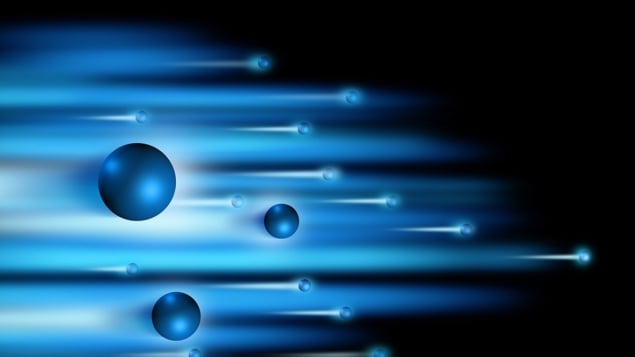
An obscure quantum-mechanical phenomenon involving a warm glow visible only to accelerated observers, long thought almost impossible to detect, should be measurable in the laboratory after all. So say three physicists in Canada and the US, who reckon that the “Unruh effect” could be seen by accelerating an electron along a very well-defined path while showering it with microwaves. Evidence for the effect, they calculate, should become available after just a few hours of observations – in contrast to the signature from an unirradiated particle, which would take longer than the history of the universe to emerge.
The special theory of relativity, which Albert Einstein unveiled back in 1905, applies to observers who are not accelerating – those in “inertial” frames of reference. It tells us that some very unusual effects occur when one observer moves relative to another at close to the speed of light – including the fact that time and velocity are no longer absolute quantities but depend on the observer’s frame of reference. However, the theory has little to say about the effects of acceleration.
Theorists investigated this problem in the 1970s, seeking to work out what an accelerated observer would experience as they move through the vacuum of deep space. William Unruh, Stephen Fulling and Paul Davies worked out that while an inertial observer would see nothing in particular, the accelerating individual would be basked in a (relatively) warm glow of particles from the quantum vacuum – slightly increasing the temperature in their frame of reference from zero to some finite amount.
Extreme acceleration
However, the effect is extremely small. To measure a temperature rise of just 1 K, an observer would have to accelerate at 1020 m/s2 – unimaginably higher than anything a human being could achieve. Such accelerations can be attained by electrons thrust along inside powerful particle accelerators, but even then, the odds of detecting the (probabilistic) phenomenon are tiny – just one in 1018 per second.
In the latest work, Barbara Šoda and Achim Kempf of the University of Waterloo in Canada take a new approach to calculating the quantum effects of acceleration. In particular, they consider how to boost the chances of a particle experiencing the Unruh effect by exposing it to electromagnetic radiation as it is accelerated. They explain that the amplification of the “stimulated” Unruh effect relative to the conventional, spontaneous variety is comparable to the difference between the spontaneous and stimulated emission of light by atoms – the latter being used in laser technology.
Doing the algebra, they conclude that the probability of seeing the stimulated Unruh effect rises in proportion to the number of photons in the stimulating radiation (compared with the spontaneous effect). As such, they argue, it should in principle be possible to slash the time needed for observing the effect by sending an accelerated electron through an intense electromagnetic field. Pointing out that state-of-the-art microwave cavities can store some 1015 photons, they reckon that a measurable effect could be seen after just a few hours of observation.
Unwanted absorption
There is a snag in that their calculations reveal a second quantum effect that should be experienced by an accelerating particle. This is resonant absorption, of the kind that any atom would undergo when exposed to radiation of the right frequency. But the researchers believe that this shouldn’t be a showstopper, arguing that given just the right trajectory an accelerated particle would experience the stimulated Unruh effect while undergoing practically no absorption.
A suitable experiment to generate such an acceleration is currently being developed by Vivishek Sudhir and colleagues at the Massachusetts Institute of Technology in the US. Sudhir, who collaborated with Šoda and Kempf on this latest research, says the idea is to use a “cryogenic ‘table-top’ microwave cavity” to trap and accelerate a single electron and then measure the mechanical recoil of the electron in the lab frame of reference as it emits and absorbs Unruh photons in its own accelerated frame. But he is reluctant to provide details about the acceleration method and on how he and his colleagues intend to achieve the necessary measurement sensitivity.

Einstein’s general theory of relativity tested by star orbiting a black hole
Indeed, Anatoly Svidzinsky of Texas A&M University in the US doubts that the Unruh effect can be directly detected experimentally. He says that a paper published by himself and some colleagues last year anticipated the current work, using the notion of negative frequency (or energy). He argues that stimulation without absorption could in principle be achieved without an external photon source, but relying instead on self-amplification – the fact that Unruh emission from one or more of a group of accelerated atoms in their ground state should stimulate other atoms within the group to do the same thing (energy conservation dictating that the photons can’t be absorbed). But he cautions that the effect would be miniscule in any realistic experiment.
If the newly proposed experimental scheme does see the light of day, the result might have implications beyond the Unruh effect itself. As Šoda and Kempf point out, the local equivalence of acceleration and gravity implies that the Unruh effect is closely related to Hawking radiation – which is the heat black holes are thought to emit from beyond their event horizons. Given the new findings, they suggest that Hawking radiation might also be stimulated – not by any lab-based photon source but by naturally-occurring ambient radiation near black holes.
The research is described in Physical Review Letters.



